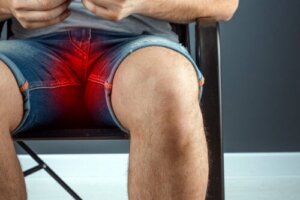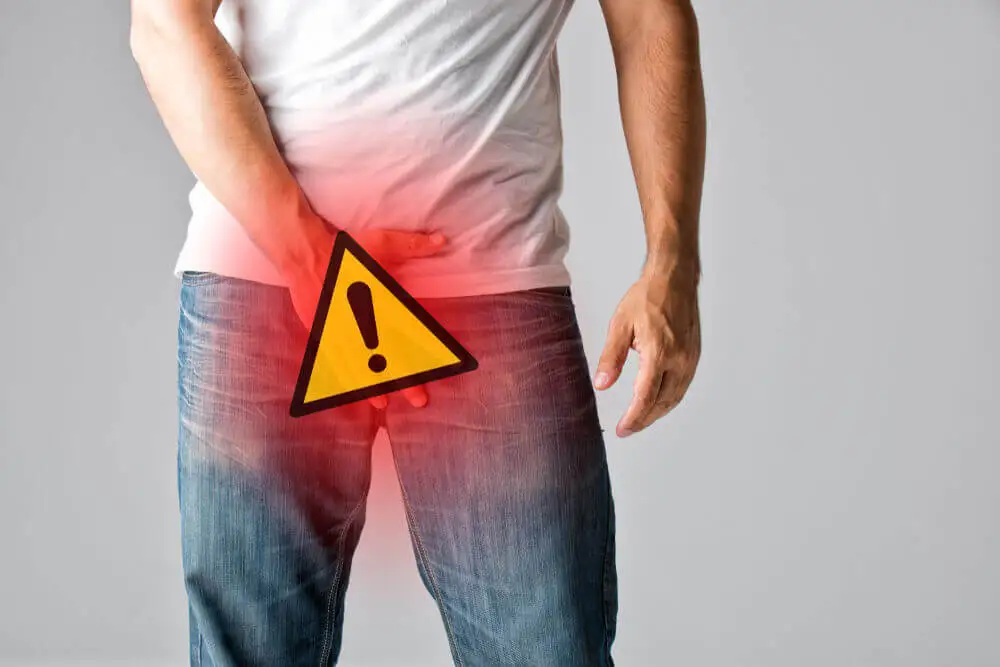Itching of the Penis: Causes and Treatments


Reviewed and approved by the nurse Leidy Mora Molina
Itching in the male intimate area generally occurs when there’s inflammation at the head of the penis. However, this symptom can have many causes, ranging from allergies and lack of hygiene or excess humidity to more serious problems such as fungal infections or sexually transmitted diseases (STDs). As you can see, itching of the penis requires a medical diagnosis.
To maintain the correct health of this body part, it’s necessary to wash it every day and to acquire habits that help to keep away possible infections. Therefore, when itching in the penis lasts for more than a week, it’s advisable to see a doctor.
Causes of itching in the penis and its possible treatments
This symptom can be generated at any point in life by incorrect practices that affect the health of the penis. However, there are some possible causes that are more serious than others that can cause inflammation of the area. Read on and discover the 10 most common causes of this symptom.
We think you may also enjoy reading this article: Short Frenulum on the Glans Penis: Symptoms, Care and Treatment
1. A lack of hygiene
One of the most common causes of penile inflammation is poor regular hygiene. When the penis is not cleaned regularly, smegma accumulates under the glans, and even more so in uncircumcised people.
This is a natural secretion, both in men and women, but should be cleaned every day in order to prevent the development of fungi and bacteria that cause itching and irritation.
The intimate area requires daily cleaning. To wash the penis properly, retract the foreskin completely and use a neutral soap. Rinse with plenty of water and make sure not to leave any product residue.

2. Allergies
The penis is a delicate organ that requires specific care. Allergies in the area are very common and occur when using inappropriate products.
Certain soaps and condoms, when in direct contact with the skin, can cause irritations that end in itching. In addition, care should be taken with synthetic clothing and materials.
The first thing to do is to find out which product is causing the irritation and stop using it. It’s advisable to use neutral soap in the intimate area and try to wear cotton clothes that are not too tight. If you suspect that condoms are the reason, you may have a latex allergy. If this is your case, look for alternatives made of a different material.
3. Human papillomavirus (HPV)
HPV is one of the most common and easily spread sexually transmitted diseases. One of its main characteristics in men is the appearance of warts on the penis and in the perianal area.
According to a study by the University of Washington, more than half of sexually active people are infected with HPV at some point in their lives. This virus is transmitted by unprotected genital-to-genital contact.
There is still no cure or specific treatment. Vaccines can help prevent it, but once acquired, the body must eliminate it on its own. If skin lesions, such as warts, are present, they should be professionally removed.
Like this article? You may also like to read: Pearly Penile Papules: What Are They and How to Treat Them
4. Genital psoriasis
When a man has this dermatological condition somewhere on his body, it’s likely that he can develop it later on his penis. Genital psoriasis causes skin cells to flake off, resulting in dry, itchy patches.
It’s important to note that psoriasis cannot be cured, but it can be treated to control its uncomfortable symptoms. Try to always keep the intimate area as clean as possible and give priority to cold water. Hot water can cause dryness in the area.
5. Candidiasis
This fungal infection caused by the fungus Candida albicans causes intense itching of the penis, as well as painful rashes. Its main risk factor is the lack of proper hygiene, which causes a large accumulation of fungus on the glans penis. However, it can also be a sign of autoimmune diseases, such as HIV.
Research from the Mountain Research Center concluded that prevention is the most effective treatment, much more so than eradicating the fungus with antifungal agents. Candidiasis is usually treated with the use and application of medications such as clotrimazole, miconazole, fluconazole, or nystatin.
6. Chlamydia and itching of the penis
Anyone can become infected with chlamydia at some point in their lives if they have unprotected sex. This is one of the most common sexually transmitted diseases and is caused by the bacterium Chlamydia trachomatis.
Men can get the disease in the urethra (inside of the penis), rectum, and throat. Some of the most common symptoms are burning of the penis, discharge, and painful urination.
A Georgetown University School of Medicine study concluded that this is the most frequently reported sexually transmitted disease in the United States, accounting for more than 1 million infections a year.
Chlamydia infections are usually treated with antibiotics. Sometimes they’re taken only once, but in more extreme cases, the drugs may be given for up to 7 days.
During treatment, sexual intercourse should be avoided so as not to infect a partner. Once cured, the best way to avoid reinfection is to always use a condom.
7. Genital eczema
Atopic dermatitis, also known as eczema, is a condition that can cause irritation and itching of the penis. It’s usually the result of genetic and environmental factors. Some of its most common symptoms are red patches, dry and scaly skin, severe itching, and pus-filled blisters.
Before contemplating possible treatments, a dermatologist should be consulted to confirm whether the itching on the penis is the result of eczema. Some of the possible treatments include the application of topical corticosteroids, such as hydrocortisone.

8. Jock itch and itching of the penis
Tinea cruris, also known as jock itch, is a genital infection caused by dermatophyte fungi. It’s usually caused by excessive sweating and lack of hygiene in the area. Its most common symptoms are red spots and irritation on the penis.
Remember that daily cleaning of the penis helps to maintain its health in optimal conditions. Try to improve your hygiene habits to alleviate the symptoms.
9. Bad shaving
When shaving around the penis, it’s important to only shave the area with a razor in perfect condition to avoid unnecessary cuts and irritation. Very old razors can store fungus and bacteria between the blades.
When shaving your penis, try to do it after a warm shower. Apply a generous amount of shaving gel to the entire area and then proceed in the direction of hair growth.
This will make the process much easier and prevent ingrown hairs or pimples on or around the penis. After you’re done, you can moisturize the skin with a light cream or body oil.
10. Pubic lice
Crabs, also called pubic lice, are small yellowish insects that usually live in the genital area of humans. Since they’re parasites, they need blood to survive.
Their main symptom is intense itching of the penis, in addition to the appearance of nits, as the lice eggs are called. These are transmitted through sexual contact or with clothing, towels, or sheets.
Usually, the fastest and most effective treatment for the elimination of crabs are topical lotions that kill them. Tonics containing permethrin or creams containing pyrethrin or piperonyl butoxide can also be used. These products are readily available in pharmacies and do not require a prescription.
11. Trichomoniasis
According to a Centers for Disease Control and Prevention publication, trichomoniasis is one of the most common sexually transmitted diseases. It’s caused by the protozoan parasite Trichomonas vaginalis and causes symptoms in both men and women.
For men, there’s often an uncomfortable irritating or itching sensation inside the penis, which may be accompanied by some discharge. The symptoms may become more evident when urinating.
Itching of the penis should not be ignored
There’s no need to ignore or hide this symptom out of modesty or shame. If you consult a health professional, you should not be ashamed, as he/she will find the best solution for you.
Especially in the case of a sexually transmitted infection, it’s of vital importance to stop the spread and not infect others. This implies a serious responsibility on your part.
All cited sources were thoroughly reviewed by our team to ensure their quality, reliability, currency, and validity. The bibliography of this article was considered reliable and of academic or scientific accuracy.
- Biblioteca Nacional de Medicina. Virus del papiloma humano. Consultado el 19 de junio de 2024. https://medlineplus.gov/spanish/hpv.html
- El‐Gohary, M., van Zuuren, E. J., Fedorowicz, Z., Burgess, H., Doney, L., Stuart, B., … & Little, P. (2014). Topical antifungal treatments for tinea cruris and tinea corporis. Cochrane Database of Systematic Reviews, (8). https://www.cochranelibrary.com/cdsr/doi/10.1002/14651858.CD009992.pub2/abstract
- Gnann Jr, J. W., & Whitley, R. J. (2016). Genital herpes. New England Journal of Medicine, 375(7), 666-674. https://www.nejm.org/doi/full/10.1056/NEJMcp1603178
- Martins, N., Ferreira, I. C., Barros, L., Silva, S., & Henriques, M. “Candidiasis: predisposing factors, prevention, diagnosis and alternative treatment”. Mycopathologia. (2014). 177(5-6), 223–240. https://link.springer.com/article/10.1007/s11046-014-9749-1
- Woo, Y. R., Han, Y., Lee, J. H., Lee, Y. B., Kim, J. E., Kim, M., … & Cho, S. H. (2021). Real‐world prevalence and burden of genital eczema in atopic dermatitis: a multicenter questionnaire‐based study. The Journal of Dermatology, 48(5), 625-632. https://onlinelibrary.wiley.com/doi/abs/10.1111/1346-8138.15817
- Clínica Mayo. (2022). Alergia al látex. Consultado el 25 de junio de 2024. https://www.mayoclinic.org/es/diseases-conditions/latex-allergy/symptoms-causes/syc-20374287
- Clínica Mayo. (2023). Infección por hongos en los hombres: ¿cómo puedo saber si tengo una? Consultado el 25 de junio de 2024. https://www.mayoclinic.org/es/male-yeast-infection/expert-answers/faq-20058464
- Koutsky, L., (1997). Epidemiology of genital human papillomavirus infection. Am J Med. 102(5A):3-8. https://pubmed.ncbi.nlm.nih.gov/9217656/
- Martins N., Ferreira I., Barros L., Silva S., & Henriques M., (2014). Candidiasis: predisposing factors, prevention, diagnosis and alternative treatment. Mycopathologia. 177(5-6):223-40. https://pubmed.ncbi.nlm.nih.gov/24789109/
This text is provided for informational purposes only and does not replace consultation with a professional. If in doubt, consult your specialist.








